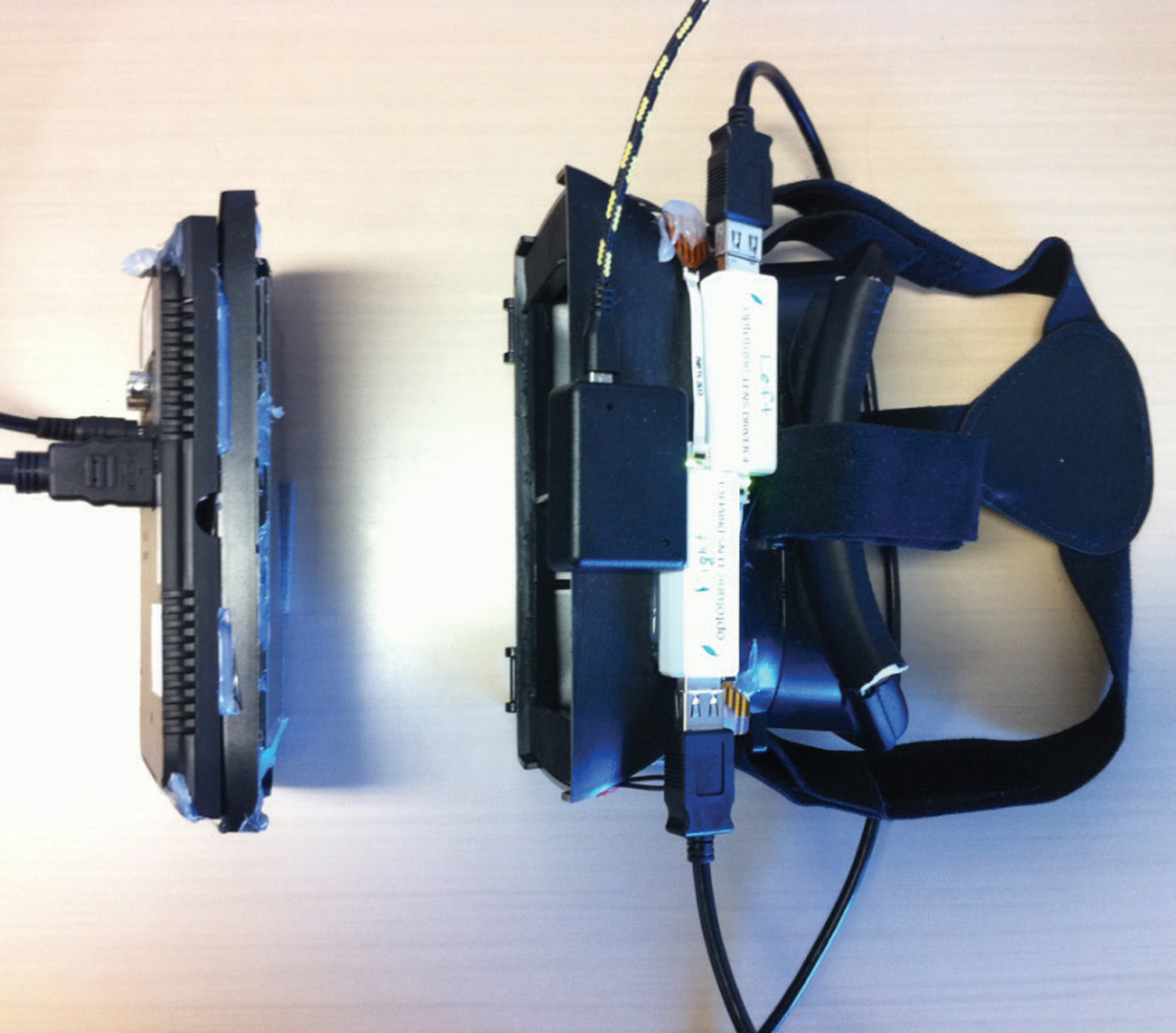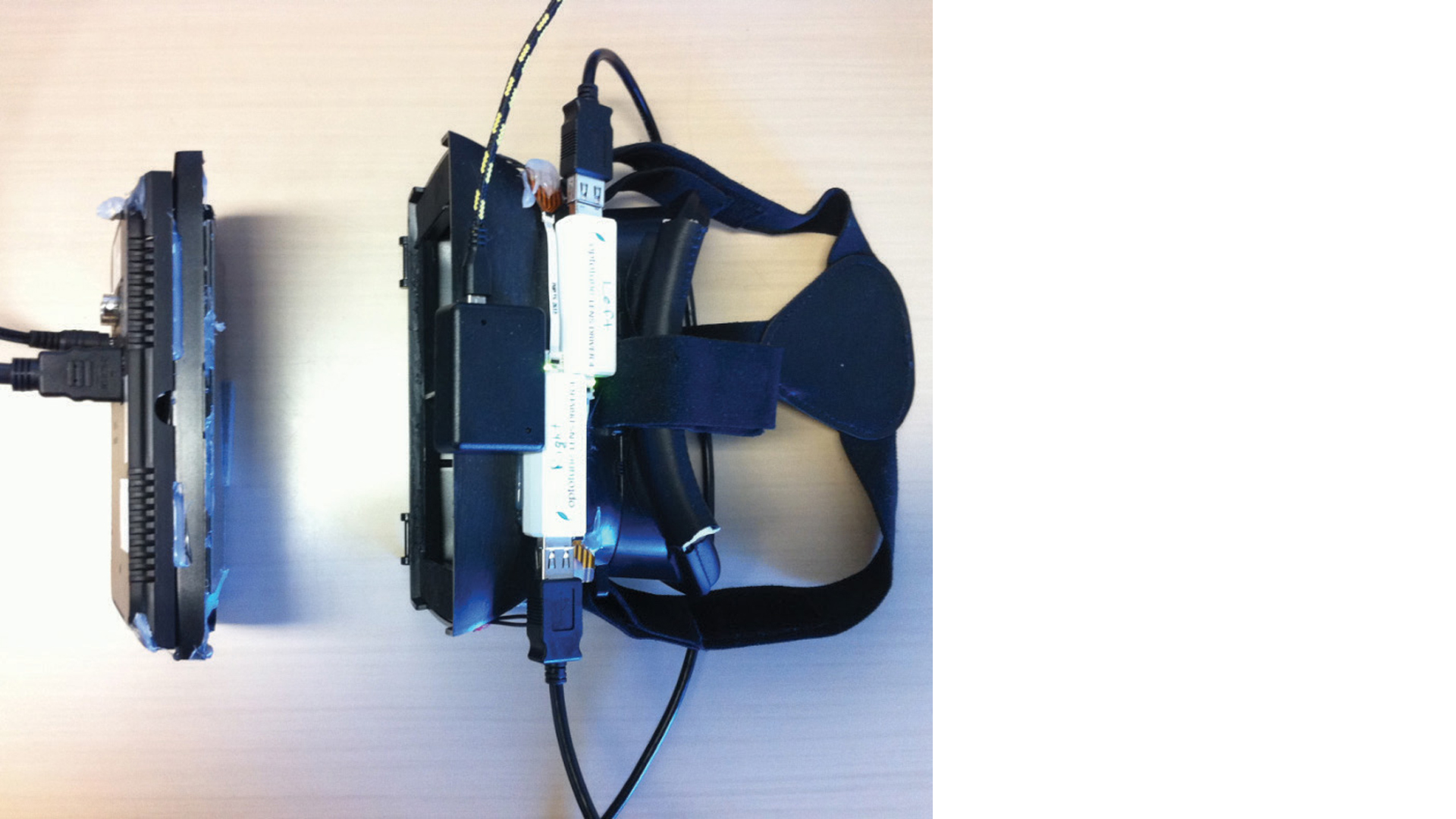“Accommodation and comfort in head-mounted displays” by Wetzstein, Bui, Banks and Drettakis
Conference:
Title:
- Accommodation and comfort in head-mounted displays
Session/Category Title: Time to Focus
Presenter(s)/Author(s):
Moderator(s):
Abstract:
Head-mounted displays (HMDs) often cause discomfort and even nausea. Improving comfort is therefore one of the most significant challenges for the design of such systems. In this paper, we evaluate the effect of different HMD display configurations on discomfort. We do this by designing a device to measure human visual behavior and evaluate viewer comfort. In particular, we focus on one known source of discomfort: the vergence-accommodation (VA) conflict. The VA conflict is the difference between accommodative and vergence response. In HMDs the eyes accommodate to a fixed screen distance while they converge to the simulated distance of the object of interest, requiring the viewer to undo the neural coupling between the two responses. Several methods have been proposed to alleviate the VA conflict, including Depth-of-Field (DoF) rendering, focus-adjustable lenses, and monovision. However, no previous work has investigated whether these solutions actually drive accommodation to the distance of the simulated object. If they did, the VA conflict would disappear, and we expect comfort to improve. We design the first device that allows us to measure accommodation in HMDs, and we use it to obtain accommodation measurements and to conduct a discomfort study. The results of the first experiment demonstrate that only the focus-adjustable-lens design drives accommodation effectively, while other solutions do not drive accommodation to the simulated distance and thus do not resolve the VA conflict. The second experiment measures discomfort. The results validate that the focus-adjustable-lens design improves comfort significantly more than the other solutions.
References:
1. Ernest A Walton Ball. 1952. A Study in Consensual Accommodation. Optometry & Vision Science 29, 11 (1952), 561–574. Google ScholarCross Ref
2. Fergus W Campbell. 1960. Correlation of Accommodation Between the Two Eyes. Journal of the Optical Society of America 50, 7 (1960), 738–738.Google ScholarCross Ref
3. Emmanuel Chirre, Pedro Prieto, and Pablo Artal. 2015. Dynamics of the Near Response Under Natural Viewing Conditions with an Open-view Sensor. Biomedical Optics Express 6, 10 (2015), 4200–4211. Google ScholarCross Ref
4. Bruce G Cumming and Stuart J Judge. 1986. Disparity-induced and Blur-induced Convergence Eye Movement and Accommodation in the Monkey. Journal of Neurophysiology 55, 5 (1986), 896–914.Google ScholarCross Ref
5. Alexander Duane. 1912. Normal Values of the Accommodation at all Ages. Journal of the American Medical Association 59, 12 (1912), 1010–1013. Google ScholarCross Ref
6. Andrew T Duchowski, Donald H House, Jordan Gestring, Rui I Wang, Krzysztof Krejtz, Izabela Krejtz, Radosław Mantiuk, and Bartosz Bazyluk. 2014. Reducing Visual Discomfort of 3d Stereoscopic Displays with Gaze-contingent Depth-of-Field. In Proc. ACM SAP. 39–46.Google ScholarDigital Library
7. Bruce JW Evans. 2007. Monovision: a Review. Ophthalmic and Physiological Optics 27, 5 (2007), 417–439.Google ScholarCross Ref
8. Frederick L Ferris, Aaron Kassof, George H Bresnick, and Ian Bailey. 1982. New Visual Acuity Charts for Clinical Research. American Journal of Ophthalmology 94, 1 (1982), 91–96.Google ScholarCross Ref
9. Edgar F Fincham and John Walton. 1957. The Reciprocal Actions of Accommodation and Convergence. The Journal of Physiology 137, 3 (1957), 488–508. Google ScholarCross Ref
10. S Kay Fisher, Kenneth J Ciuffreda, and Steven Hammer. 1987. Interocular Equality of Tonic Accommodation and Consensuality of Accommodative Hysteresis. Ophthalmic and Physiological Optics 7, 1 (1987), 17–20.Google Scholar
11. John G Fryer and Duane C Brown. 1986. Lens Distortion for Close-range Photogrammetry. Photogrammetric Engineering and Remote Sensing 52, 1 (1986), 51–58.Google Scholar
12. Robert T Held, Emily A Cooper, James F O’Brien, and Martin S Banks. 2010. Using Blur to Affect Perceived Distance and Size. ACM Transactions on Graphics 29, 2 (2010), 19:1–16.Google ScholarDigital Library
13. Sébastien Hillaire, Anatole Lécuyer, Rémi Cozot, and Géry Casiez. 2008. Using an Eye-tracking System to Improve Camera Motions and Depth-of-Field Blur Effects in Virtual Environments. In IEEE Virtual Reality Conference. IEEE, 47–50. Google ScholarCross Ref
14. David M Hoffman, Ahna R Girshick, Kurt Akeley, and Martin S Banks. 2008. Vergence-Accommodation Conflicts Hinder Visual Performance and Cause Visual Fatigue. Journal of Vision 8, 3 (2008), 33–63.Google ScholarCross Ref
15. Xinda Hu and Hong Hua. 2014. Design and Assessment of a Depth-fused Multi-focal-plane Display Prototype. Journal of Display Technology 10, 4 (2014), 308–316. Google ScholarCross Ref
16. Paul V Johnson, Jared AQ Parnell, Joohwan Kim, Christopher D Saunter, Gordon D Love, and Martin S Banks. 2016. Dynamic Lens and Monovision 3D Displays to Improve Viewer Comfort. Optics Express 24, 11 (2016), 118:08–27.Google Scholar
17. Joohwan Kim, David Kane, and Martin S Banks. 2014. The Rate of Change of Vergence-Accommodation Conflict Affects Visual Discomfort. Vision Research 105 (2014), 159–165. Google ScholarCross Ref
18. Robert Konrad, Emily A Cooper, and Gordon Wetzstein. 2016. Novel Optical Configurations for Virtual Reality: Evaluating User Preference and Performance with Focus-tunable and Monovision Near-eye Displays. In SIGCHI 2016. ACM, 1211–1220.Google ScholarDigital Library
19. Frank L Kooi and Alexander Toet. 2004. Visual Comfort of Binocular and 3D Displays. Displays 25, 2 (2004), 99–108.Google ScholarCross Ref
20. Philip B Kruger, Steven Mathews, Karan R Aggarwala, and Nivian Sanchez. 1993. Chromatic Aberration and Ocular Focus: Fincham Revisited. Vision Research 33, 10 (1993), 1397–1411.Google ScholarCross Ref
21. Marc Lambooij, Marten Fortuin, Ingrid Heynderickx, and Wijnand IJsselsteijn. 2009. Visual Discomfort and Visual Fatigue of Stereoscopic Displays: A Review. Journal of Imaging Science and Technology 53, 3 (2009), 1–14. Google ScholarCross Ref
22. Gordon D Love, David M Hoffman, Philip JW Hands, James Gao, Andrew K Kirby, and Martin S Banks. 2009. High-speed Switchable Lens Enables the Development of a Volumetric Stereoscopic Display. Optics Express 17, 18 (2009), 15:716–725.Google Scholar
23. Kevin J MacKenzie, David M Hoffman, and Simon J Watt. 2010. Accommodation to Multiple-focal-plane Displays: Implications for Improving Stereoscopic Displays and for Accommodation Control. Journal of Vision 10, 8 (2010), 1–22.Google ScholarCross Ref
24. Andrew Maimone, Gordon Wetzstein, Matthew Hirsch, Douglas Lanman, Ramesh Raskar, and Henry Fuchs. 2013. Focus 3D: Compressive Accommodation Display. ACM Transactions on Graphics 32, 5 (2013), 1–13. Google ScholarDigital Library
25. Elwin Marg. 1951. An Investigation of Voluntary as Distinguished from Reflex Accommodation. Optometry & Vision Science 28, 7 (1951), 347–356. Google ScholarCross Ref
26. Theodore G Martens and Kenneth N Ogle. 1959. Observations on Accommodative Convergence; Especially its Nonlinear Relationships. American Journal of Ophthalmology 47, 1 Pt 2 (1959), 455–462. Google ScholarCross Ref
27. Michael Mauderer, Simone Conte, Miguel A Nacenta, and Dhanraj Vishwanath. 2014. Depth Perception with Gaze-contingent Depth of Field. In SIGCHI 2014. ACM, 217–226.Google Scholar
28. Rahul Narain, Rachel A Albert, Abdullah Bulbul, Gregory J Ward, Martin S Banks, and James F O’Brien. 2015. Optimal Presentation of Imagery with Focus Cues on Multi-plane Displays. ACM Transactions on Graphics (TOG) 34, 4 (2015), 59:1–12.Google ScholarDigital Library
29. John A Nevin. 1969. Signal Detection Theory and Operant Behavior: A Review of David M. Green and John A. Swets’ Signal Detection Theory and Psychophysics. 1. Journal of the Experimental Analysis of Behavior 12, 3 (1969), 475–480. Google ScholarCross Ref
30. Hubert Nguyen. 2007. Gpu Gems 3. Addison-Wesley Professional.Google Scholar
31. OpenCV. 2016. Camera calibration With OpenCV. http://docs.opencv.org/2.4/doc/tutorials/calib3d/camera_calibration/camera_calibration.html. (2016). [Online; accessed 5-April-2017].Google Scholar
32. Keiichiro Otani, Takumi Yoshida, Hideaki Nii, Naoki Kawakami, and Susumu Tachi. 2008. Active Focus Control with Eye Gaze Detection for Depth Cognition. Asiagraph2008 (2008).Google Scholar
33. Nitish Padmanaban, Robert Konrad, Tal Stramer, Emily A. Cooper, and Gordon Wetzstein. 2017. Optimizing virtual reality for all users through gaze-contingent and adaptive focus displays. Proceedings of the National Academy of Sciences 114, 9 (2017), 2183–2188. Google ScholarCross Ref
34. Michael Potmesil and Indranil Chakravarty. 1982. Synthetic Image Generation with a Lens and Aperture Camera Model. ACM Transactions on Graphics (TOG) 1, 2 (1982), 85–108. Google ScholarDigital Library
35. Clifton M Schor. 1992. A Dynamic Model of Cross-coupling Between Accommodation and Convergence: Simulations of Step and Frequency Responses. Optometry & Vision Science 69, 4 (1992), 258–269. Google ScholarCross Ref
36. James E Sheedy, Michael G Harris, and Cheslyn M Gan. 1993. Does the Presbyopic Visual System Adapt to Contact Lenses?. Optometry & Vision Science 70, 6 (1993), 482–486.Google ScholarCross Ref
37. Takashi Shibata, Joohwan Kim, David M Hoffman, and Martin S Banks. 2011. The Zone of Comfort: Predicting Visual Discomfort with Stereo Displays. Journal of Vision 11, 8 (2011), 11:1–29.Google ScholarCross Ref
38. Michael Stengel, Steve Grogorick, Martin Eisemann, Elmar Eisemann, and Marcus A Magnor. 2015. An Affordable Solution for Binocular Eye Tracking and Calibration in Head-mounted Displays. In Proceedings of the 23rd Annual ACM Conference on Multimedia. ACM, 15–24. Google ScholarDigital Library
39. Yasuhiro Takaki. 2006. High-density Directional Display for Generating Natural Three-dimensional Images. Proc. IEEE 94, 3 (2006), 654–663. Google ScholarCross Ref
40. Matthieu Urvoy, Marcus Barkowsky, and Patrick Le Callet. 2013. How Visual Fatigue and Discomfort Impact 3D-TV Quality of Experience: A Comprehensive Review of Technological, Psychophysical, and Psychological Factors. Annals of Telecommunications 68, 11–12 (2013), 641–655.Google ScholarCross Ref
41. Margarita Vinnikov, Rob S Allison, and S Fernandes. 2016. Impact of Depth of Field Simulation on Visual Fatigue: Who are Impacted? And how? Int. J. of Human-Computer Studies 91 (2016), 37–51. Google ScholarDigital Library
42. Dorothy M Win-Hall, Jaime Houser, and Adrian Glasser. 2010. Static and Dynamic Measurement of Accommodation Using the Grand Seiko WAM-5500 Autorefractor. Optometry and Vision Science 87, 11 (2010), 11:1–19.Google Scholar
43. Shunnan Yang and James E Sheedy. 2011. Effects of Vergence and Accommodative Responses on Viewer’s Comfort in Viewing 3D Stimuli. In SPIE Electronic Imaging. International Society for Optics and Photonics, 1–13.Google Scholar





